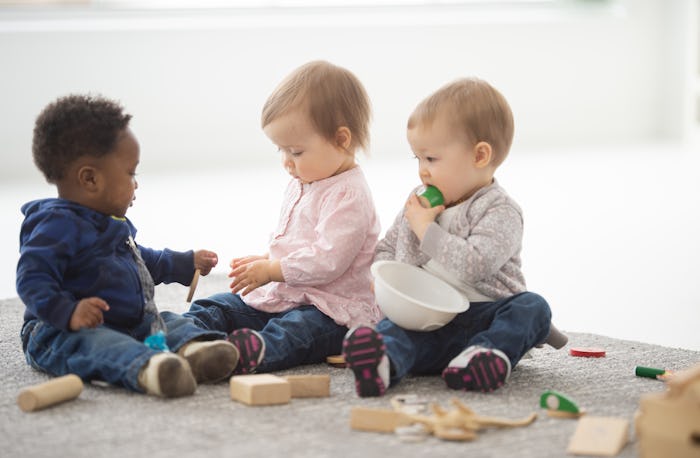Montessori

Introduce Your Baby To Montessori With These Fun Learning Toys
It’s all about textures, natural sounds, and exploration.
In their first 12 months of life, babies develop at a rapid pace, and toys can have the potential to really aid in that development. Montessori toys for babies are especially good for this because their entire purpose is to encourage curiosity and exploration without being overstimulating. Even though their designs are typically simple, they are definitely not lacking in educational value.
The basic designs of Montessori toys often allow babies an opportunity to find a variety of ways to use them through open-ended play. A great example of this is the Pikler triangle, a toy Jackie Horton, a Montessori and early education teacher, loves. "It offers a safe space for your child to explore their limbs and learn how to trust their bodies," she tells Romper in an interview, "They learn their boundaries, strengthen their muscles, and have a designated space to explore their urge to crawl and climb."
Montessori toys also encourage independence, Horton explains. Some of her favorites for babies include blocks, simple puzzles, and activities that let them explore independently, like pouring water. “Anything that allows a child to attempt these things with little guidance is sure to be a great Montessori activity,” she says. For more ideas, check out these amazing toys.
We only include products that have been independently selected by Romper's editorial team. However, we may receive a portion of sales if you purchase a product through a link in this article.
1Soft Interactive Books
Books made with soft fabrics and various textures with interactive features are a great way for babies to learn while also engaging and exploring.
2Wooden Teethers
Wooden teethers are perfect for curious babies. Look for some that offer grainy textures, ways to play, and have curves to explore like this star and moon teether.
3Play Gym
This baby play gym offers just enough stimulation, textures, and interactive play for growing babies without being overwhelming.
4Crinkle Toy
Crinkle and tag toys are a good way for babies to explore different textures and sounds. This panda toy is great because it offers these benefits without being overwhelming.
5Pikler Triangle
"Pikler triangles are great for babies just starting to stand or pull up and also great for toddlers that want to climb everything," says Horton.
6Balancing Toy
This toy teaches cause and effect, introduces the concept of balance, and offers plenty of stimulation thanks to the sounds the beads make when the toy moves around.
7Wood Rattles
Babies can explore textures, hear new sounds, witness cause and effect, and develop their grasp with wooden rattles like these.
8Rolling Drum
Babies who are learning how to crawl can push this rolling drum around in front of them. Even if they’re not crawling yet, sitters can hold on to this toy and shake it around to watch the balls inside move and hear them make different sounds.
9Object Permanence Box
"Object permanence boxes are great for infants," Horton says. "Babies will learn that just because they don't see something does not mean that it isn't there."
10Stacking Toys
Stacking toys are great for spatial awareness and exploration. These ones are made from smooth plastic and can be played with on the floor or in the bathtub.
11Play Car
Babies can feel different textures and figure out different ways to grasp this car. They can also push it and see what happens when they try to roll it up or down an incline.
12Grasping Toy
This toy is a teether, grasper, rattle, and sensory toy all in one. Babies can start using it as soon as their born to start strengthening their grasp and will continue to find new ways to interact with it as they develop.
Expert:
Jackie Horton, Early Education & Montessori Teacher
This article was originally published on